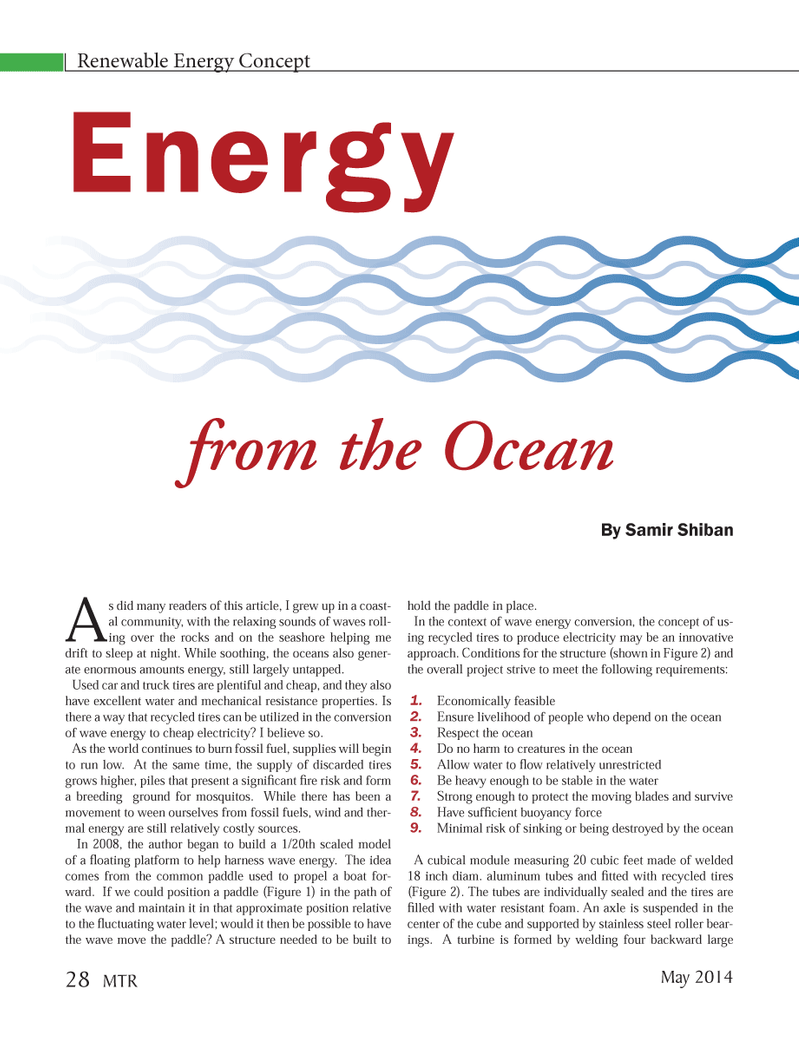
Page 28: of Marine Technology Magazine (May 2014)
AUV Operations
Read this page in Pdf, Flash or Html5 edition of May 2014 Marine Technology Magazine
Renewable Energy Concept As did many readers of this article, I grew up in a coast- al community, with the relaxing sounds of waves roll- ing over the rocks and on the seashore helping me drift to sleep at night. While soothing, the oceans also gener- ate enormous amounts energy, still largely untapped. Used car and truck tires are plentiful and cheap, and they also have excellent water and mechanical resistance properties. Is there a way that recycled tires can be utilized in the conversion of wave energy to cheap electricity? I believe so. As the world continues to burn fossil fuel, supplies will begin to run low. At the same time, the supply of discarded tires grows higher, piles that present a signiÞ cant Þ re risk and form a breeding ground for mosquitos. While there has been a movement to ween ourselves from fossil fuels, wind and ther- mal energy are still relatively costly sources. In 2008, the author began to build a 1/20th scaled model of a ß oating platform to help harness wave energy. The idea comes from the common paddle used to propel a boat for- ward. If we could position a paddle (Figure 1) in the path of the wave and maintain it in that approximate position relative to the ß uctuating water level; would it then be possible to have the wave move the paddle? A structure needed to be built to hold the paddle in place.In the context of wave energy conversion, the concept of us- ing recycled tires to produce electricity may be an innovative approach. Conditions for the structure (shown in Figure 2) and the overall project strive to meet the following requirements: 1. Economically feasible2. Ensure livelihood of people who depend on the ocean 3. Respect the ocean4. Do no harm to creatures in the ocean5. Allow water to ß ow relatively unrestricted 6. Be heavy enough to be stable in the water 7. Strong enough to protect the moving blades and survive 8. Have sufÞ cient buoyancy force 9. Minimal risk of sinking or being destroyed by the ocean A cubical module measuring 20 cubic feet made of welded 18 inch diam. aluminum tubes and Þ tted with recycled tires (Figure 2). The tubes are individually sealed and the tires are Þ lled with water resistant foam. An axle is suspended in the center of the cube and supported by stainless steel roller bear- ings. A turbine is formed by welding four backward large Energy By Samir Shibanfrom the Ocean 28 MTRMay 2014MTR #4 (18-33).indd 28MTR #4 (18-33).indd 285/13/2014 9:58:04 AM5/13/2014 9:58:04 AM

 27
27

 29
29
